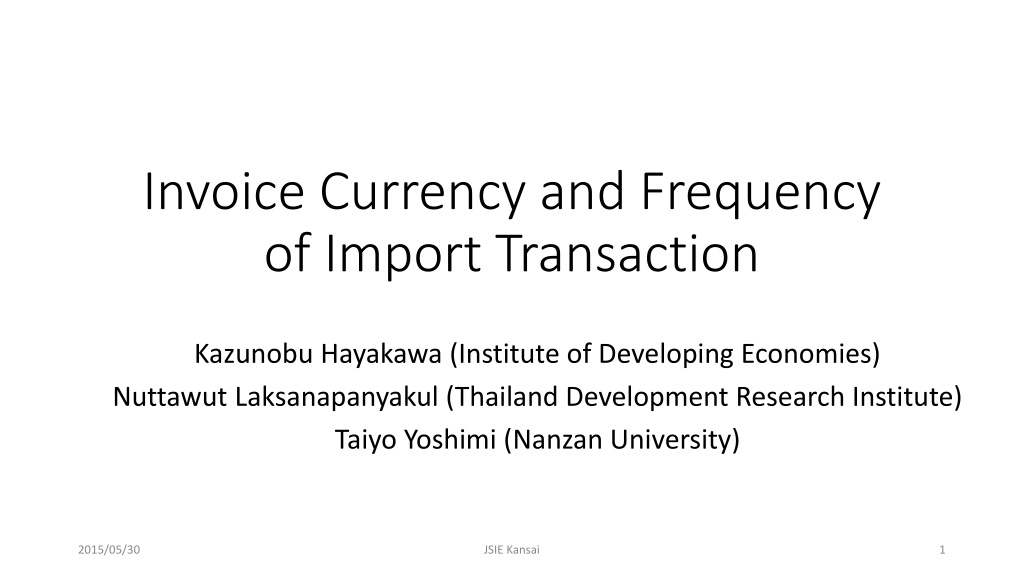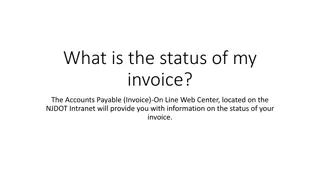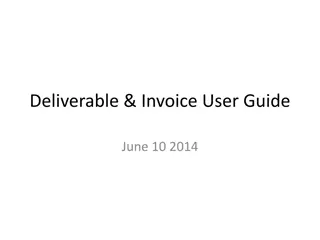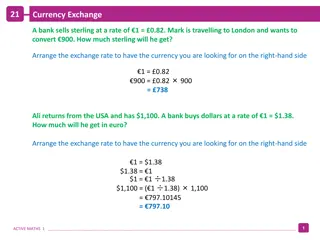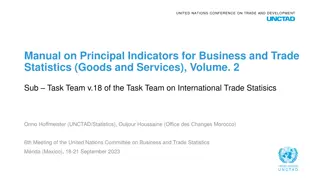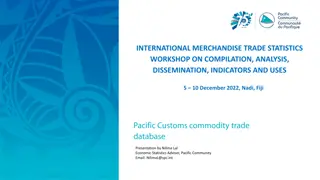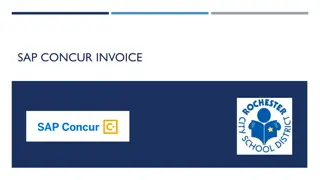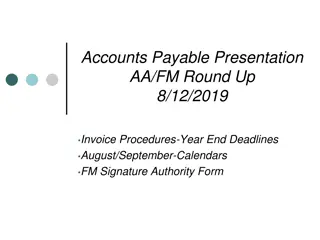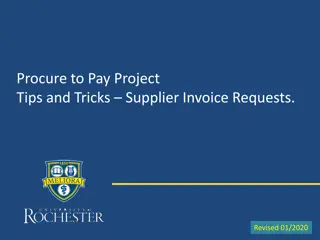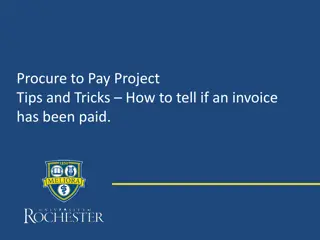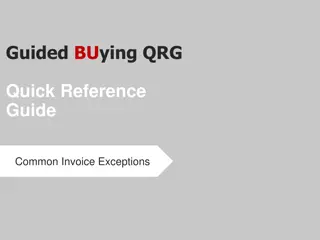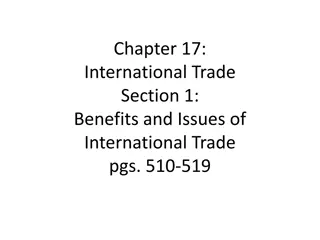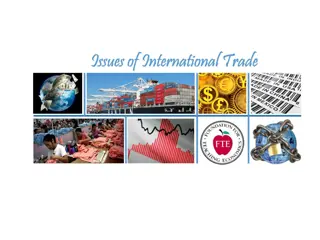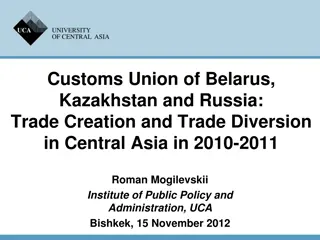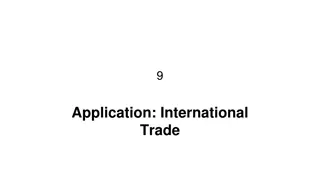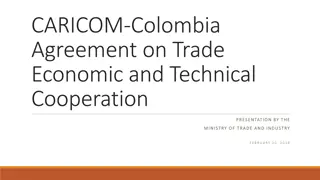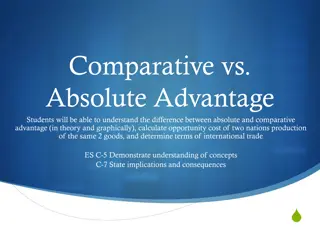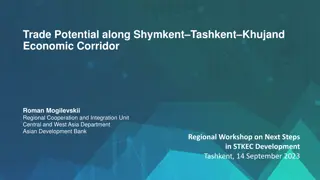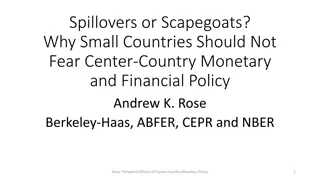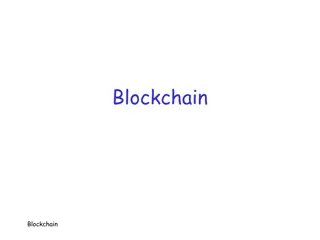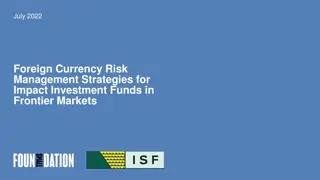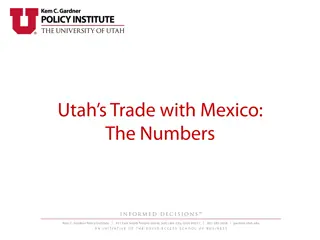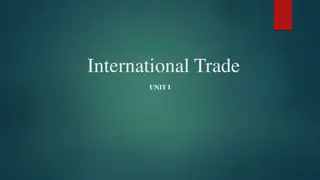Benefits of Invoice Currency in International Trade: Analysis and Implications
Explore the benefits of using invoice currency in international trade, focusing on the implications for importers. The study presents a model of endogenous choice of import frequency and invoice currency, revealing how Home Currency Invoicing (HCI) can help mitigate exchange-rate risks and reduce importing costs. Detailed findings show that HCI is associated with just-in-time orders and offers significant benefits for Thai importers, with implications for trade frequency and shipment values. Literature review integrates insights from previous studies to highlight the advantages of HCI in managing currency fluctuations and optimizing trade relationships.
Download Presentation

Please find below an Image/Link to download the presentation.
The content on the website is provided AS IS for your information and personal use only. It may not be sold, licensed, or shared on other websites without obtaining consent from the author. Download presentation by click this link. If you encounter any issues during the download, it is possible that the publisher has removed the file from their server.
E N D
Presentation Transcript
Invoice Currency and Frequency of Import Transaction Kazunobu Hayakawa (Institute of Developing Economies) Nuttawut Laksanapanyakul (Thailand Development Research Institute) Taiyo Yoshimi (Nanzan University) 2015/05/30 JSIE Kansai 1
Outline 1. Motivation 2. Major Findings 3. The Model 4. Data 5. Invoice Currency, Import Frequency and Value per Shipment 6. Benefits of HCI 7. Conclusion 2015/05/30 JSIE Kansai 2
1. Motivation What is the benefits of running an international currency? We examine this from the view of invoice currency in imports. Invoice currency and exchange-rate risk Home currency invoicing (HCI): No ER risk for home importers. Foreign currency invoicing (FCI): Importers manage ER risk with some costs. HCI vs FCI HCI: ER risk doesn t exist. FCI: Importers have to pay costs of ER risk management, but importing cost will become cheaper if the foreign invoice currency will be discounted enough. 2015/05/30 JSIE Kansai 3
What we do We present a model of endogenous choice of import frequency and invoice currency. Based on the model, we infer the benefits of HCI. The benefits are represented by fixed costs of ER risk management under FCI in the model, and inferred with observable information. A highly disaggregated dataset on Thai imports: company code, transaction date, trade value and quantity, invoice currency in each transaction, etc We also examine the relation between invoice currency, import frequency, and value per shipment. 2015/05/30 JSIE Kansai 4
2. Major Findings Those benefits of average Thai importer range between 7.3% (1,500USD) and 17.1% (3,600USD) of one-time shipment value. Those benefits become larger when Turnover Share of the export country currency is lower, or the export country is one of partners of Thailand s RTA. Import frequency is higher and the value per shipment is smaller for products invoiced in customers (importers ) currency than those not priced in it. HCI is associated with just-in-time orders. 2015/05/30 JSIE Kansai 5
Literature Trade frequency Kropf and Saur (2014) infer fixed costs per shipment, and examine determinants of shipment frequency and the value per shipment. Bekes et al. (2014) introduce uncertainty into consideration. Choice of invoice currency Goldberg and Tille (2009) examine the choice of the invoice currency through bargaining btw exporters and importers. Gopinath et al. (2010) construct a model where importer choose the invoice currency. We combine these two literature to infer the benefits of HCI. 2015/05/30 JSIE Kansai 6
3. The Model Partial equilibrium model a la Kropf and Saur (2014) with infinite number of countries. Two differences: Importers optimize in our model. Invoice currencies are endogenously determined. Agents Representative household Final-good producers (importers of intermediate inputs) Financial institution (implicit) Intermediate-good producer (implicit) 2015/05/30 JSIE Kansai 7
Structure (simplified) Country Bank(s) House Final Final Final Intermediate Country Country Bank(s) Bank(s) House House Final Final Final Final Final Final Intermediate Intermediate 2015/05/30 JSIE Kansai 8
3.1. Representative Household Preference ? = ? ? ? 1 ??? ? 1 1?? ? 0 Demand and Price Index , 1 < ? < ?? ?? ? ??= ? 1 1?? 1 ? 1 ??? ? 0 2015/05/30 JSIE Kansai 9
3.2. Forward Exchange Rates FCI and HCI FCI: ?? HCI: ? = 1, ??= 0 and ??= 0 Heterogeneous Forward Premium ??depends on ?. Interpretation: Depending on firm owner s knowledge and experience, which are assumed to be exogenous, premium can vary. Example: More experienced owners can find better financial institutions, which offer better premium. ?? = ????? and ??> 0 2015/05/30 JSIE Kansai 10
3.3. Final-good Producers Technology ??= ??? Marginal Cost ???=????? ? ? ? Consumer Price ? ? 1 Shipment interval is denoted by ?. Normalizing one period by 1, ? ?(?+??)? ?? ? ? ??(? ) = 1is interpreted as import frequency. 2015/05/30 JSIE Kansai 11
Profits Operating Profit 1 ? ?(?+??)? ?? ? ?? 1 ??? = ? ? ? ? 1 Present Value per Shipment ?? ?? ??? ?? = ?1 ? ?+ ? 1 ?+?? ? ? ? 0 Present Value of all shipments in a period ???? ?=0 ? ? ? ??= ? and ??= ?+?? ?+ ? 1 ?+?? ? ? ? ?? 2015/05/30 JSIE Kansai 12
3.4. Frequency and Value per Shipment Frequency and invoice currency are simultaneously determined. Each firm choose HCI if and only if ????? ?????. Optimization max ?? FOC ? ? ?+ ? 1 ?+?? ?? ? ? + ? 1 ? + ?? ? 1 ? + ?? ?? ????, where ?? ? ? ? 1 ?+??+ ?? ?+ ? 1 ?+??= 0 2015/05/30 JSIE Kansai 13
Threshold Forward Premium Threshold premium ? is defined by ?????= ?????. ? is uniquely determined. Choice of invoice currency ??< ? FCI: Home currency will become significantly expensive at the payment date. FCI lowers importing costs in terms of home currency. ? ?? HCI: Costs of ER risk management ??motivate importers to choose the home currency in invoicing. 2015/05/30 JSIE Kansai 14
Forward Premium and Import Frequency 2015/05/30 JSIE Kansai 15
Value per Shipment Value per shipment in terms of the home currency ??? ? ??(? ) ? ?(?+??) ?? = ?? 1 1 ?? 0 1 ?? ? ?+?? 2015/05/30 JSIE Kansai 16
Propositions Proposition 1: Import frequency of FCI importers is lower than that of HCI ones around the cutoff forward premium, which is more likely when the fixed cost of exchange-rate risk management is larger. Proposition 2: The existence of the fixed cost of exchange-rate risk management increases the value per shipment of FCI importers over that of HCI importers. 2015/05/30 JSIE Kansai 17
3.5. Benefits of HCI Inferring ??(??= ? and ??= ?+??) ??= ???? ( 1) ?? ? 1 ?+ ? 1 ?+?? ?+???? ? ? ?+?? 1 ?? ? ? 1 ?+?? ? 1 ?+?? ? ? 1 ?+?? ? ?? 1 Inferring ?? ??= ???? ???? ( 2) ??is interpreted as the benefits of HCI. 1 + ?? ?? 2015/05/30 JSIE Kansai 18
4. Data Transaction-level import data from 2007 to 2011, which covers all commodity imports in Thailand. Customs clearing date, HS eight-digit code, export country, import firm ID, invoice currency, import values in Thai Baht (THB), import quantity, and quantity unit. 2015/05/30 JSIE Kansai 19
Figure 2. Sample Distribution of Number of Shipments per Year 6 4 Density 2 0 0 2 4 6 Number of Shipments per Year, logged 2015/05/30 JSIE Kansai 20
Figure 3. Sample Distribution of Average Import Values per Shipment .2 .15 Density .1 .05 0 0 5 10 15 20 25 Average Values in THB, logged 2015/05/30 JSIE Kansai 21
Table 1. The Decomposition of Import Transactions According to Invoice Currencies Local Producer Vehicle Number/Value Share Number/Value Share Number/Value Share Import Transactions 2007 2008 2009 2010 2011 Import Values (Million THB) 2007 2008 2009 2010 2011 315,220 345,968 354,500 427,163 479,208 0.07 0.07 0.07 0.08 0.08 1,810,002 1,910,047 1,678,244 1,967,099 2,017,907 0.39 0.38 0.35 0.35 0.34 2,518,534 2,788,492 2,762,252 3,288,345 3,406,764 0.54 0.55 0.58 0.58 0.58 210,254 220,038 182,519 255,404 289,262 0.04 0.04 0.04 0.05 0.04 987,052 1,082,668 825,785 1,042,832 1,196,530 0.20 0.19 0.19 0.18 0.18 3,645,962 4,467,971 3,385,206 4,340,484 5,129,073 0.75 0.77 0.77 0.77 0.78 2015/05/30 JSIE Kansai 22
Table 4. Basic Statistics for Import Frequency and Imports per Shipment by Invoice Currency Mean S.D. Median Maximum Frequency Local Producer Vehicle Total Values per shipment (Thousand THB) Local Producer Vehicle Total 5.559 4.227 5.174 4.831 16.224 11.324 14.359 13.416 1 1 1 1 331 365 364 365 282 421 947 695 2,494 6,169 25,995 19,479 10 27 37 30 254,875 1,961,622 7,805,302 7,805,302 2015/05/30 JSIE Kansai 23
Data Overview More than a half of all import transactions have only one shipment per year. Distribution of average imports per shipment seems to follow the log-normal distribution. Approximately 60% and 80% of import in Thailand are invoiced in the vehicle currency in terms of the number of transactions and of values, respectively. 2015/05/30 JSIE Kansai 24
5. Invoice Currency, Import Frequency and Value per Shipment Invoice Currency and Import Frequency ln?????????????= ?????? Invoice Currency and Value per Shipment ln?????????= ?????? ???+ ???? + ????+ ????? ???+ ???? + ????+ ????? 2015/05/30 JSIE Kansai 25
Table 7. Determinants of Import Frequency OLS IV (I) (II) (III) (IV) Second stage Local Currency Dummy 0.0893*** [0.0023] 0.1328*** [0.0022] 0.0763*** [0.0002] -0.0618*** [0.0011] 4,980,162 0.2354 0.6000*** [0.0133] 0.2310*** [0.0124] 0.0766*** [0.0002] -0.0620*** [0.0010] 4,744,619 0.050 ln Total Imports Exporter Dummy Number of Observations R-squared (Centered) First stage THB Export Share 4,980,162 0.1948 4,744,619 -0.0131 0.1293*** [0.0006] 0.027 1.20E+05 44547.07 0.1418*** [0.0006] 0.0321 1.40E+05 5.10E+04 Centered R-squared Cragg-Donald Wald F Kleibergen-Paap Wald rk F 2015/05/30 JSIE Kansai 26
Table 8. Robustness Checks on Import Frequency (I) IV Daily (II) IV Full (III) OLS Daily (IV) OLS Daily Estimation Method Data type Second stage Local Currency Dummy 0.2870*** [0.0202] 0.2804*** [0.0156] Vehicle Currency Dummy -0.0743*** [0.0024] -0.1006*** [0.0023] -0.1511*** [0.0024] -0.1193*** [0.0023] 0.0766*** [0.0002] -0.0620*** [0.0011] 4,980,162 0.2355 Producer Currency Dummy ln Total Imports 0.0930*** [0.0004] -0.0633*** [0.0021] 1,632,779 0.0444 0.0905*** [0.0002] -0.0616*** [0.0013] 4,744,619 0.045 Exporter Dummy Number of Observations R-squared (Centered) First stage THB Export Share 4,980,162 0.1948 0.1657*** [0.0011] 0.0283 9.08E+04 24713.77 0.1418*** [0.0006] 0.0321 1.40E+05 51233.44 Centered R-squared Cragg-Donald Wald F Kleibergen-Paap Wald rk F 2015/05/30 JSIE Kansai 27
Table 9. Determinants of Average Import Values per Shipment (I) OLS (II) IV (III) OLS Estiamtion Method Second stage Local Currency Dummy -0.5679*** [0.0050] -1.7425*** [0.0291] Vehicle Currency Dummy 0.6341*** [0.0054] 0.5179*** [0.0052] 0.3215*** [0.0024] 4,980,162 0.3950 Producer Currency Dummy Exporter Dummy 0.3248*** [0.0024] 4,980,162 0.3948 0.3144*** [0.0023] 4,806,105 -0.0054 Number of Observations R-squared (Centered) First stage THB Export Share 0.1431*** [0.0006] 0.0312 1.40E+05 52865.43 Centered R-squared Cragg-Donald Wald F Kleibergen-Paap Wald rk F 2015/05/30 JSIE Kansai 28
Invoice Currency, Import Frequency and Value per Shipment Invoice Currency and Import Frequency Frequency is higher for HCI than FCI. Proposition 1 provides a rationale. Invoice Currency and Value per Shipment Value per shipment is smaller for HCI than FCI. Proposition 2 provides a rationale. Just-in-time orders are observed for HCI. 2015/05/30 JSIE Kansai 29
6. Benefits of HCI 1. Compute ?????based on ( 1) and ( 2). 2. Estimate the following equation: ?????= ?0+ ?1????? ?0: inferred ? (fixed costs per shipment) ?1: inferred ??(fixed costs for FCI management, or benefits of HCI) ???+ ??+ ??+ ????? 2015/05/30 JSIE Kansai 30
Table 10. Fixed Costs for FCI Management (I) (II) (III) Difference 51.0769*** [7.1360] 26.5147*** [6.8806] NO NO 4,171,649 50.8037*** [7.1412] 119.2677*** [8.0531] Constant Year Dummy Export Country Dummy Number of Observations YES NO 4,171,649 YES YES 4,171,649 2015/05/30 JSIE Kansai 31
Benefits of HCI Fixed costs per shipment and benefits of HCI are significantly positive. Quantitative implications: Inferred ?: 800USD (3.9%). One-tenth of the average per- export shipment fixed costs in Swiss estimated by Kropf and Saur (2014). Inferred ??: ranges between 1,500USD (7.3%) and 3,600USD (17.1%). 2015/05/30 JSIE Kansai 32
Determinants of ?? 1. Compute ??for each exporting country based ( 1) and ( 2). 2. Examine the correlation between ??and exporting countries characteristics. GDP, GDP per capita, distance, RTA dummy, and Turnover Share. 2015/05/30 JSIE Kansai 33
Table 11. Correlation of Fixed Costs for FCI Management with Export Country Characteristics (I) (II) (III) 0.0618 [0.0793] (IV) 0.0549 [0.0915] 0.0213 [0.1145] (V) 0.0102 [0.0865] 0.0256 [0.1147] 0.0722 [0.2483] ln GDP 0.0524 [0.0915] 0.027 [0.1184] -0.1797 [0.3196] -1.2538* [0.6827] -6.3278** [2.7204] 5.1765 [3.4003] 137 0.0402 ln GDP per capita 0.0622 [0.1015] -0.1876 [0.3159] -1.1481* [0.6182] -5.7026** [2.4059] 6.2658** [2.7313] 137 0.0376 ln Distance -0.1749 [0.3115] -1.2528* [0.6825] -6.2606** [2.6892] 5.1945 [3.4133] 137 0.0398 RTA Dummy -1.0567* [0.5540] -6.6050** [2.7919] 3.5555* [2.1429] 137 0.0375 Turnover Share -6.2948** [3.1262] 3.9992 [3.2014] 137 0.0159 Constant Number of Observations R-squared 2015/05/30 JSIE Kansai 34
7. Conclusion Benefits of HCI in imports are positive, and range btw 7.3% and 17.1% of value per shipment. Those benefits are negatively correlated with Turnover Share of export country s currency and RTA dummy. Just-in-time orders with high frequency and small value per shipment are associated with HCI. 2015/05/30 JSIE Kansai 35
